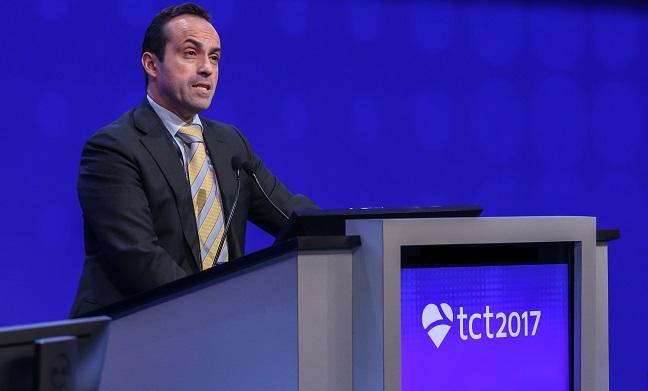DARE Supports Drug-Coated Balloon as Alternative to DES for Any In-Stent Restenosis
The SeQuent Please paclitaxel-coated balloon provided noninferior angiographic results compared with Xience.

DENVER, CO—The SeQuent Please paclitaxel-coated balloon (BBraun) provides noninferior angiographic results when compared with the Xience everolimus-eluting stent (Abbott Vascular) in patients with coronary in-stent restenosis, the DARE trial shows.
At 6 months, mean in-segment minimal lumen diameter (MLD) was 1.71 mm in the drug-coated balloon (DCB) arm and 1.74 mm in the DES arm, a difference that met criteria for noninferiority (P < 0.0001), José Henriques, MD, PhD (Academic Medical Center, Amsterdam, the Netherlands), presented at TCT 2017 here.
There were no differences in clinical outcomes, although the study was not powered for those endpoints.
“The drug-eluting balloon appears to be an alternative therapy for any in-stent restenosis, negating the need for additional stenting,” Henriques said during a press conference. He noted that the findings—published simultaneously online in the JACC: Cardiovascular Interventions—are concordant with current European guidelines, which provide class IA recommendations for both DES and DCBs for treatment of in-stent restenosis within BMS or DES.
DCBs are not currently available in the United States for use in the coronary vasculature, however, and Roxana Mehran, MD (Icahn School of Medicine at Mount Sinai, New York, NY), who served as moderator of the press conference, said she hopes that will change in the future. She pointed out that the technology has been available in Europe for over a decade.
Even though in-stent restenosis is a rare event with current-generation DES, when it does arise “what we don’t want to do is keep putting in layers of stents if we don’t need to,” she told TCTMD, adding that “having a drug-coated balloon available in the coronaries is going to make life so much easier for our patients.” That’s because patients with at least two layers of stents often end up requiring bypass surgery or brachytherapy, she noted.
David Cohen, MD (Saint Luke’s Mid America Heart Institute, Kansas City, MO), also made the case for US availability during a panel discussion at the press conference.
“This type of device, obviously with it being similar in performance to drug-eluting stents, would be a very welcome addition to our armamentarium, because one of the things I don’t like to do as a coronary interventionalist is to line up multiple stents inside of each other,” he said. “That just becomes a self-perpetuating problem. So the ability to treat these patients reasonably well without putting in more stents is a tremendous advantage in the long run.”
Infrequent but Challenging Problem
Though in-stent restenosis has become less of an issue with continuing improvements in DES technology, it remains a challenge in clinical practice, Henriques said. It is usually treated with DES, although other options include DCB, conventional balloon angioplasty, cutting balloon angioplasty, intravascular brachytherapy, laser atherectomy, and BMS.
Prior studies evaluating DCBs for in-stent restenosis have included patients with blockages in either BMS or DES, but DARE included patients originally implanted with either type of stent. At eight Dutch centers, investigators enrolled 278 patients with any in-stent restenosis (56% had restenosis in a DES) and randomized them to DCB or DES treatment. About 60% of patients presented with ACS.
Predilatation was mandated by protocol for all patients, but the actual rates were 100% and 85.1% in the DCB and DES arms, respectively. Postdilatation was more frequent in the DES group (57% vs 16%).
DES treatment resulted in a larger in-segment MLD (1.84 vs 1.72 mm; P = 0.018) and lower percent stenosis (26% vs 30%; P = 0.03) after the procedure. But those differences were offset by greater late lumen loss in the DES arm (0.45 vs 0.17 mm; P < 0.001) at the 6-month angiographic follow-up, and in-segment MLD did not differ between arms at that time point.
Clinical outcomes, including death, MI, stroke, TVR, and composite major adverse events, occurred at similar rates in the two groups.
Weighing the Pros and Cons
Four published RCTs have compared SeQuent Please with Xience for in-stent restenosis in patients implanted with either BMS or DES. Of the three involving patients with restenosis within BMS, two showed higher MLD with Xience than with SeQuent Please, with the third showing an advantage for DCBs. The RIBS IV trial of patients with in-stent restenosis within a DES showed that Xience improved MLD and reduced TVR versus SeQuent Please.
Henriques cited difficulties in comparing results across trials and said that taken together, accumulated data indicate that it would be useful to have DCBs as an available tool to treat in-stent restenosis. He noted that one of the trials showing superior angiographic results for Xience—SEDUCE—also showed a lower percentage of uncovered struts in the DCB arm at 9 months.
In their paper, he and his colleagues say that clinicians should weigh the advantages and disadvantages of each approach when choosing the appropriate treatment.
“Currently, (repeat) implantation of a DES arguably remains the most widely used treatment strategy,” they say. “Using a [drug-eluting balloon] instead of an additional stent offers the advantage of delivering antiproliferative medication to the [in-stent restenosis] lesion with no additional deployment of metal with acceptable angiographic and clinical outcomes.”
If the number of exposed stent struts could be reduced using DCBs, as suggested by SEDUCE, it is possible that the duration of dual antiplatelet therapy could be shortened, they add.
Though there are many potential treatments for in-stent restenosis, DCBs and DES remain the most commonly used, the authors say, and “the DARE trial confirms the feasibility of both treatment strategies.”
Todd Neale is the Associate News Editor for TCTMD and a Senior Medical Journalist. He got his start in journalism at …
Read Full BioSources
Baan J Jr, Claessen BE, Boerlage-van Dijk K, et al. A randomized comparison of paclitaxel-eluting balloon versus everolimus-eluting stent for the treatment of any in-stent restenosis: the DARE trial. J Am Coll Cardiol Intv. 2017;Epub ahead of print.
Disclosures
- Henriques reports receiving an unrestricted research grant from BBraun.


Comments